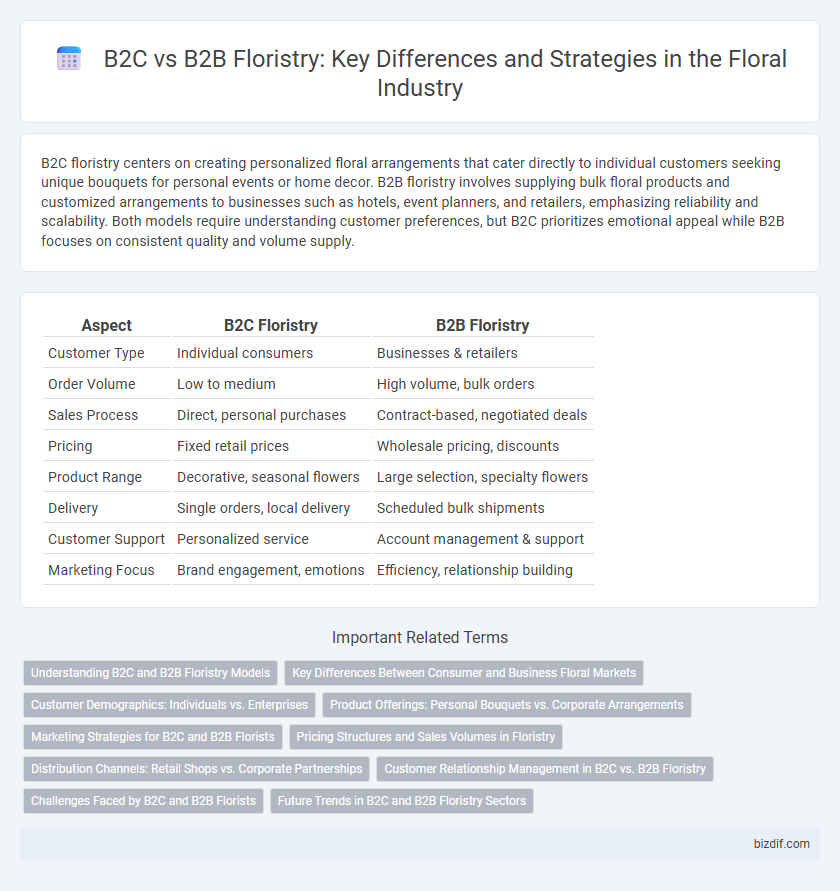B2C floristry centers on creating personalized floral arrangements that cater directly to individual customers seeking unique bouquets for personal events or home decor. B2B floristry involves supplying bulk floral products and customized arrangements to businesses such as hotels, event planners, and retailers, emphasizing reliability and scalability. Both models require understanding customer preferences, but B2C prioritizes emotional appeal while B2B focuses on consistent quality and volume supply.
Table of Comparison
| Aspect | B2C Floristry | B2B Floristry |
|---|---|---|
| Customer Type | Individual consumers | Businesses & retailers |
| Order Volume | Low to medium | High volume, bulk orders |
| Sales Process | Direct, personal purchases | Contract-based, negotiated deals |
| Pricing | Fixed retail prices | Wholesale pricing, discounts |
| Product Range | Decorative, seasonal flowers | Large selection, specialty flowers |
| Delivery | Single orders, local delivery | Scheduled bulk shipments |
| Customer Support | Personalized service | Account management & support |
| Marketing Focus | Brand engagement, emotions | Efficiency, relationship building |
Understanding B2C and B2B Floristry Models
B2C floristry focuses on direct sales to individual customers, emphasizing personalized arrangements, seasonal promotions, and gift-oriented services tailored for events like weddings and holidays. B2B floristry involves supplying bulk flowers and arrangements to businesses such as hotels, corporate offices, and event planners, prioritizing volume, consistent quality, and long-term contracts. Understanding these models helps florists optimize inventory management, pricing strategies, and customer engagement to effectively serve each market segment.
Key Differences Between Consumer and Business Floral Markets
B2C floristry targets individual customers seeking personalized floral arrangements for occasions like birthdays, weddings, and anniversaries, emphasizing aesthetic appeal and emotional connection. B2B floristry focuses on bulk orders for corporate events, hotels, and retailers, prioritizing consistency, cost-efficiency, and logistical coordination. The consumer market values unique design and immediacy, whereas the business market requires scalable solutions and long-term partnerships.
Customer Demographics: Individuals vs. Enterprises
B2C floristry primarily serves individual customers purchasing flowers for personal occasions such as birthdays, anniversaries, or home decor, emphasizing personalized service and convenience. B2B floristry targets enterprises like event planners, hotels, and corporate offices, requiring bulk orders, consistent quality, and timely delivery to support large-scale events and corporate branding. Understanding these distinct customer demographics helps florists tailor marketing strategies, product offerings, and customer service approaches effectively.
Product Offerings: Personal Bouquets vs. Corporate Arrangements
B2C floristry specializes in personalized bouquets tailored for individual occasions such as birthdays, anniversaries, and romantic gestures, often featuring seasonal flowers and custom designs. B2B floristry focuses on corporate arrangements that enhance office aesthetics and event spaces, providing durable, large-scale floral displays with a professional and elegant appearance. These corporate offerings prioritize longevity and brand alignment, contrasting with the highly customizable and emotionally expressive nature of personal bouquets in the B2C market.
Marketing Strategies for B2C and B2B Florists
B2C floristry marketing strategies emphasize emotional appeal, seasonal promotions, and social media engagement to attract individual consumers seeking personal gifts and event decor. B2B florists prioritize relationship-building, bulk purchasing agreements, and targeted campaigns highlighting reliability and customization for corporate clients like event planners and retailers. Data-driven insights and CRM tools enhance personalized marketing in both sectors, though messaging and channels differ to meet the unique purchasing behaviors of consumers versus businesses.
Pricing Structures and Sales Volumes in Floristry
B2C floristry typically involves higher pricing per unit due to customized arrangements and direct retail sales, targeting individual consumers with smaller order volumes. In contrast, B2B floristry operates on bulk pricing structures, offering significant discounts to businesses such as event planners or hospitality sectors, resulting in larger sales volumes. These pricing distinctions are crucial for florists to optimize profit margins and inventory management based on their target market segment.
Distribution Channels: Retail Shops vs. Corporate Partnerships
B2C floristry relies heavily on retail shops, where direct consumer engagement drives sales through personalized floral arrangements and seasonal promotions. B2B floristry emphasizes corporate partnerships, leveraging bulk orders and long-term contracts with businesses for events, office decor, and hospitality services. Distribution channels in B2B floristry often involve streamlined logistics and dedicated account management to meet consistent demand and service expectations.
Customer Relationship Management in B2C vs. B2B Floristry
B2C floristry emphasizes personalized customer relationship management by leveraging direct interactions, tailored floral arrangements, and loyalty programs to enhance individual customer satisfaction and repeat purchases. In contrast, B2B floristry focuses on long-term partnerships, account management, and volume-based contracts, requiring CRM systems that manage complex client data and streamline corporate ordering processes. Effective CRM in B2B floristry integrates detailed client preferences and delivery schedules, while B2C CRM prioritizes real-time engagement and personalized marketing campaigns.
Challenges Faced by B2C and B2B Florists
B2C florists face challenges such as fluctuating consumer demand, seasonality impacting sales, and the need for personalized customer service to meet diverse preferences. B2B florists struggle with maintaining large-scale supply chains, ensuring consistent quality for corporate clients, and managing bulk orders with tight deadlines. Both sectors must address inventory management and competitive pricing while adapting to evolving market trends and economic fluctuations.
Future Trends in B2C and B2B Floristry Sectors
The future of B2C floristry is shaped by personalized floral subscriptions, eco-friendly packaging, and AI-driven customer customization, enhancing direct-to-consumer engagement. In B2B floristry, digital supply chain integration, bulk automation, and sustainable sourcing are pivotal for meeting corporate demand and event-based floral services. Both sectors increasingly leverage augmented reality for virtual floral arrangements, driving innovation and customer experience in the floristry market.
B2C floristry vs B2B floristry Infographic

 bizdif.com
bizdif.com